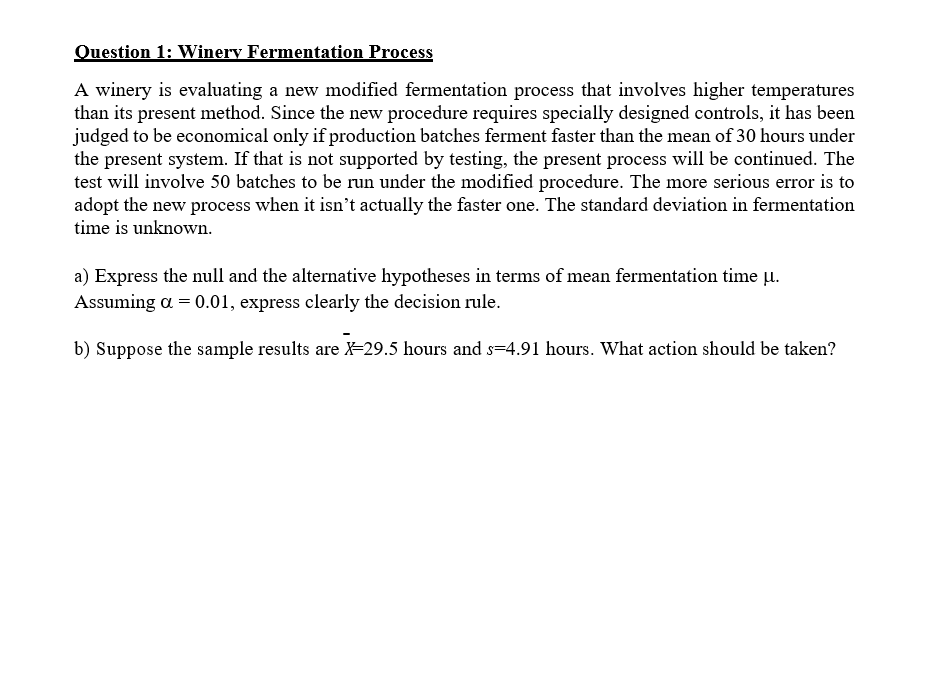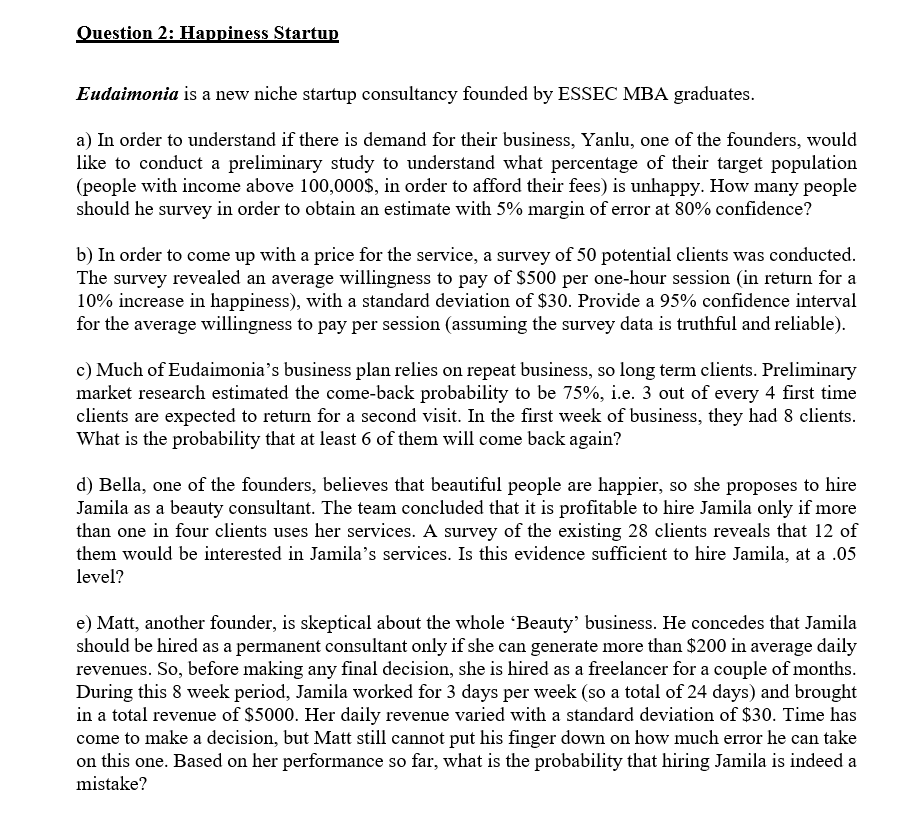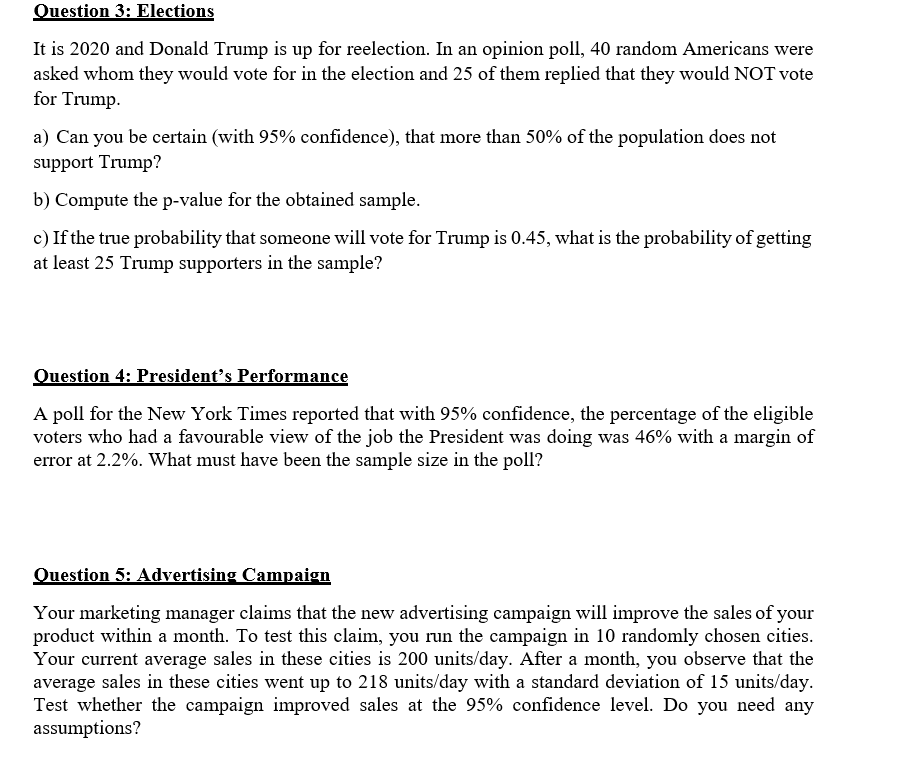Stats HW Help
Question 1: Winery Fermentation Process A winery is evaluating a new modified fermentation process that involves higher temperatures than its present method. Since the new procedure requires specially designed controls, it has been judged to be economical only if production batches ferment faster than the mean of 30 hours under the present system. If that is not supported by testing, the present process will be continued. The test will involve 50 batches to be run under the modified procedure. The more serious error is to adopt the new process when it isn't actually the faster one. The standard deviation in fermentation time is unknown. a) Express the null and the alternative hypotheses in terms of mean fermentation time J. Assuming o = 0.01, express clearly the decision rule. b) Suppose the sample results are X-29.5 hours and s=4.91 hours. What action should be taken?Question 2: Happiness Startun Euduimoniu is a new niche startup consultancy founded by ESSEC NIBA graduates. a) In order to understand if there is demand for their business, Yanlu, one of the founders, would like to conduct a preliminary study to understand what percentage of their target population (people with income above 100,000$, in order to aord their fees) is unhappy. How many people should he survey in order to obtain an estimate with 5% margin of error at 80% condence? b) In order to come up with a price for the service, a survey of 50 potential clients was conducted. The survey revealed an average willingness to pay of $500 per one-hour session (in return for a 10% increase in happiness), with a stande deviation of $30. Provide a 95% condence interval for the average willingness to pay per session (assuming the survey data is truthful and reliable). c) Much of Eudaimonia's business plan relies on repeat business, so long term clients. Preliminary market research estimated the come-back probability to be 75%, i.e. 3 out of every 4 rst time clients are expected to return for a second visit. In the rst week of business, they had 8 clients. What is the probability that at least 6 of them will come back again? d) Bella, one of the founders, believes that beautiful people are happier, so she proposes to hire Jamila as a beauty consultant. The team concluded that it is protable to hire Jamila only if more than one in four clients uses her services. A survey of the existing 28 clients reveals that 12 of them would be interested in Jamila's services. Is this evidence sufcient to hire Jamila, at a .05 level? e) Matt, another founder, is skeptical about the whole 'Beauty' business. He concedes that Jarnila should be hired as a permanent consultant only if she can generate more than $200 in average daily revenues. So, before making any nal decision, she is hired as a 'eelancer for a couple of months. During this 8 week period, Jarnila worked for 3 days per week (so a total of 24 days) and brought in a total revenue of $5000. Her daily revenue varied with a standard deviation of $30. Time has come to make a decision, but Matt still cannot put his nger down on how much error he can take on this one. Based on her performance so far, what is the probability that hiring Jarnila is indeed a mistake? Question 3: Elections It is 2020 and Donald Trump is up for reelection. In an opinion poll, 40 random Americans were asked whom they would vote for in the election and 25 of them replied that they would NOT vote for Trump. a) Can you be certain (with 95% confidence), that more than 50% of the population does not support Trump? b) Compute the p-value for the obtained sample. c) If the true probability that someone will vote for Trump is 0.45, what is the probability of getting at least 25 Trump supporters in the sample? Question 4: President's Performance A poll for the New York Times reported that with 95% confidence, the percentage of the eligible voters who had a favourable view of the job the President was doing was 46% with a margin of error at 2.2%. What must have been the sample size in the poll? Question 5: Advertising Campaign Your marketing manager claims that the new advertising campaign will improve the sales of your product within a month. To test this claim, you run the campaign in 10 randomly chosen cities. Your current average sales in these cities is 200 units/day. After a month, you observe that the average sales in these cities went up to 218 units/day with a standard deviation of 15 units/day. Test whether the campaign improved sales at the 95% confidence level. Do you need any assumptions









